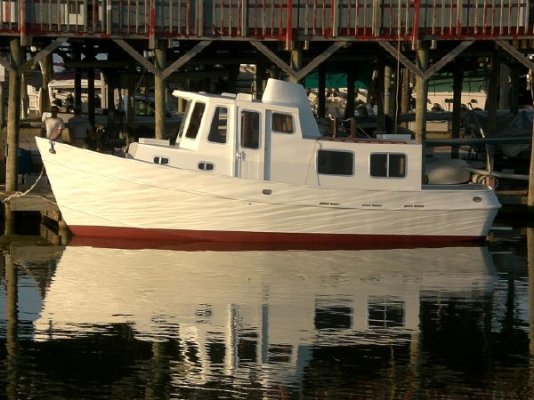Rustybarge
Guru
Hi All,
Nothing compares to steel for cheapness and strength for home building at £500/ton for 6mm plate. build outside, weld outside, transport in sections, paint with two pack industrial bridge paint: change parts of the design during the build!
so I was thinking if you could build a semi-displacement trawler of about 34' in Steel it would be a very very economical and quick to fabricate trawler project.
Came across these Pedro Dutch trawler designers in steel, but displacement not S/D.
http://www.pedro-boat.co.uk/pages/models/pedro-donky-34.html
7 tons 34', right 'on the money' for a GRP 34' trawler!
Could this design be easily adapted to semi-displacement?
Technical specification
Length o.a.: 10,30 m
Beam: 3,40 m
Draught: 1,00 m
Air draught: +/- 2,55 m
Fuel tank: 400 liter
Fresh water tank: 250 liter
Holding tank: 250 liter
Berths: 2 - 4
Weight: 7.100 kg
Engine: Perkins M92B, 64 kW (86 hp)*
Other engines possible
CE-design category: B


Nothing compares to steel for cheapness and strength for home building at £500/ton for 6mm plate. build outside, weld outside, transport in sections, paint with two pack industrial bridge paint: change parts of the design during the build!
so I was thinking if you could build a semi-displacement trawler of about 34' in Steel it would be a very very economical and quick to fabricate trawler project.
Came across these Pedro Dutch trawler designers in steel, but displacement not S/D.
http://www.pedro-boat.co.uk/pages/models/pedro-donky-34.html
7 tons 34', right 'on the money' for a GRP 34' trawler!
Could this design be easily adapted to semi-displacement?
Technical specification
Length o.a.: 10,30 m
Beam: 3,40 m
Draught: 1,00 m
Air draught: +/- 2,55 m
Fuel tank: 400 liter
Fresh water tank: 250 liter
Holding tank: 250 liter
Berths: 2 - 4
Weight: 7.100 kg
Engine: Perkins M92B, 64 kW (86 hp)*
Other engines possible
CE-design category: B


Last edited:


















